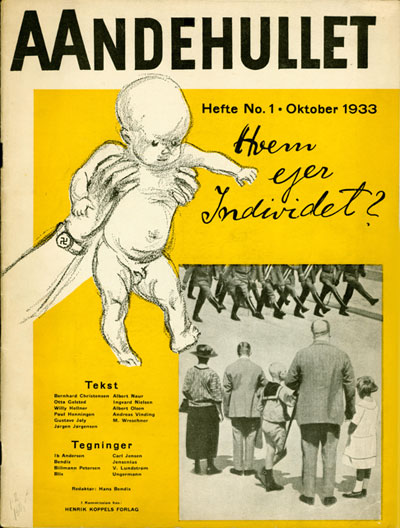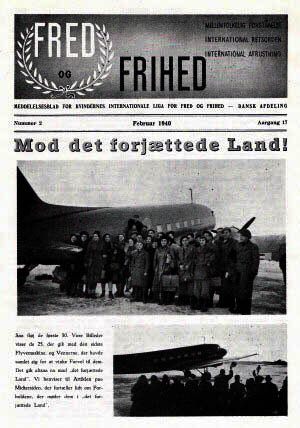The Danish Peace Academy
Holger Terp: Danish Peace History
Working paper 1
Refugee work before World War Two

 In 1938 three
Danish women, Melanie Oppenheim, Kirsten Gloerfelt-Tarp and Thora
Daugaard from the Danish Women’s Council and the
Women’s International League for Peace and Freedom, began
the immigration of German and Austrian Jewish children to Denmark,
which “needed agricultural students”! 325 Jewish
children came to Denmark and in December 1939 most of them were
shipped to Haifa in Palestine123.
In 1938 three
Danish women, Melanie Oppenheim, Kirsten Gloerfelt-Tarp and Thora
Daugaard from the Danish Women’s Council and the
Women’s International League for Peace and Freedom, began
the immigration of German and Austrian Jewish children to Denmark,
which “needed agricultural students”! 325 Jewish
children came to Denmark and in December 1939 most of them were
shipped to Haifa in Palestine123.
Shortly before the World War Two aid to the families of prisoners in German concentration camps was organised by the organisation Skandia-Hjælp. Ellen Hørup as well as other Danes like Else Zeuthen had protested against the Spanish civil war 1936-1939, the battlefield of Capitalism124. The Danish country wide collecting of aid in cooperation with Swedish and French refugee organisations to the suffering women and children of the Spanish civil war began in January 1936. The Danes and Swedes worked also together with the International Save the Children Fund at Geneva125.
They might have been inspired both by the well known work of Nansen in Russia, the Danish refugee work for starving Austrian children after WW 1126, and by a lecture held September 30, 1935 by Pierre Ceresole in Copenhagen on “Conscientious objection and reconstruction in ravaged areas”127 and by aid work of the War Resister’s International128.
At the time of the outbreak of the Second World War a Danish pen pal initiative was supported by the popular weekly Familie Journalen. During the occupation the Danish pen pals could only correspond with other Danes as they refused to write letters to the Germans. After the occupation the art of writing letters to foreigners in order to make friends and improve language skills was renewed. The Danish pen pal organisation might be a part of the International Interchange of Boys.
In April 1939 the Danish author and refugee friend Karin Michaëlis visits New York. She returns to Denmark in 1946129.
The German professor Walther A. Berendsohn (1884-1984) from the University of Hamburg, was living in Denmark after 1933. He collected German language émigré literature for his study Die Humanistischen Front (Züric 1946 and Worms 1976)130.
Also the German educator Dr. Franz Mockrauer was living in Denmark in 1937131. Mockrauer offered lectures to persons interested in subjects related to peace.
Notes

123 Hammerich, Poul: Valkyrierne : En
nordisk kvindefront trodser valne myndigheder og rager
jødebørn ud af Hitlers bål 1938-40. In:
Undtagelsen : En krønike om jøderne i Norden. 1992.
pp. 321-334.
Rünitz, Lone: Af hensyn til konsekvenserne : Danmark og
flygtningespørgsmålet 1933-1940 - Odense : Syddansk
Universitetsforlag, 2005. - 577 pp. ; University of Southern
Denmark studies in history and social sciences, vol. 303). - ISBN:
87-7838-988-7
Based on a very large source material the National Police and the
Ministry of Justice proceedings is investigated how it developed
within the framework that policymakers and the law defined in the
period 1933-1939.
Rünitz, Lone: Diskret ophold. 2010.
Rünitz, Lone: The Politics of Asylum in Denmark in the Wake of
the Kristallnacht – A Case Study, undated.
Rünitz, Lone: Diskret ophold. 2010.
125 Den danske Landsindsamling til Hjælp for Kvinder og Børn i Spanien / The Danish National Collection to Help Women and Children in Spain. In: Fred og Frihed, 1936:2 pp. 12-13.
126 Jacobsen, Sigurd: Wienerbørn i Landflygtighed : En historisk Oversigt. 1943. – 319 pp.
127 Ceresole, Pierre: Militærnægtelse og Genopbyggelse af hærgede Egne / Conscientious Objection and Rebuilding of Ravaged Areas. In: Freds-Varden, 1935 no. 5 pp. 71-76.
128 Lukowitz, David C.: Pacifists and Class Warfare : The Spanish Civil War. In: 50 Years of war Resistance : What Now?. London: WRI, 1972 pp. 22-23.
129 Michaëlis, Karin: Vidunderlige Verden I-III, 1948-1950.
Michaëlis, Karin: Little Troll. New York, 1946.
Nielsen, Birgit S.: Karin Michaëlis hjælp til tyske emigranter. In: Steffensen, Steffen: Tysksprogede emigranter i Danmark, 1987 pp. 33-58. See also: the Karin Michaëlis Society / Karin Michaëlis selskabet.
130 Steffensen, Steffen: Professor Walther A. Berendsohn. In: På flugt fra nazismen : Tysksprogede emigranter i Danmark, 1987 / translated into German: Willy Dähnhardt und Birgit S. Nielsen (Hrsg.): Exil in Dänemark. Deutschsprachige Wissenschaftler, Künstler und Schriftsteller im dänischen Exil nach 1933. (Westholsteinische Verlagsanstalt Boyens & Co., 1993). 731 p.
131 Fred og Frihed, 1937:10 p. 84.
|
|
|